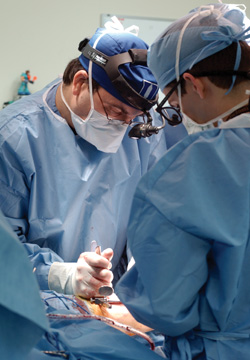
Gregory Mencio, M.D., left, and Jason Conaughty, M.D., perform surgery to correct scoliosis, which is a curvature of the spine (below).
Photos by Dana Johnson
Procedure straightens scoliosis curves

Sixteen-year-old Christan Holmes had no idea her back was slowly sliding sideways, giving an S-shape to her spine that might impact her height and comfort and possibly contibute to major health issues down the road.
Luckily, an astute family physician (Scott Brooks, M.D.) had noted the slight curve two years earlier and she began seeing a pediatric orthopedic specialist regularly. Though she felt fine, this winter her specialist, Greg Mencio, M.D., professor of Orthopaedics and Rehabilitation at the Monroe Carell Jr. Children's Hospital at Vanderbilt, documented that the curve of her spine was worsening.
“We had Christan using a brace for about seven months,” Mencio said, “But in about 25 percent of patients, and we don't fully understand why, the curvature progresses as it did in Christan's case.”
To compound matters, Christan's normal adolescent growth spurt accelerated the curvature.
The curve increased by more than 25 percent, to 50 degrees, in less than six months. The next step was surgery to correct the existing deformity and prevent progression and problems in adulthood.
“We recommend surgery for scoliosis once the curve exceeds about 45 to 50 degrees in the upper (thoracic) spine and 40 to 45 degrees in the lower (lumbar) spine,” Mencio said.
Although the curve in Christan's spine looks quite dramatic on x-rays, it's actually difficult to tell there's a problem just by looking at her.
“That's what we thought,” said Christan's mother, Donna Holmes. “She's like any busy teen; she comes and goes quickly. So if Dr. Brooks had not made the diagnosis, I don't think we would have known there was a problem until much later.”
Christan did say she was beginning to experience back pain, but she attributed the discomfort to other things.
“I had to wear the brace for about 16 hours a day, so as soon as I got home from school I'd put it on, and you can't shower in it, and it's kind of uncomfortable to sleep in,” Christan said. “I was beginning to get lower back pain when I would sit or stand for long periods of time, so I'm glad that I'm able to have this corrected.”
The family opted to schedule surgery during the school year, since Christan is an excellent student and is in her junior year at Franklin High School.
“We knew there wouldn't be a problem with her academics, and since she'll need several weeks recovery, we wanted to be sure she has a great summer before she has to start looking at colleges,” said Donna Holmes.
The procedure to correct her curvature was performed on March 3.
“Traditionally we would do the surgical approach from the back and place two rods that would span both the upper and lower spine. But since Christan's primary curve is in the lower portion of the spine, we're able to use a more limited anterior approach thru the side of the torso,” Mencio said.
The curve in Christan's upper spine is currently less than 20 degrees, so they will do nothing to that part of her back.
“In the anterior approach, we make an incision on the side of the body, expose the four or five vertebrae that that are most curved, and implant a single rod to correct the deformity while avoiding major work on the rest of her back. Christan will still have a significant scar on her side, but there will be no disruption of the spinal muscles,” said Mencio. “And operating on fewer levels will be better for preserving mobility and health of her spine later in life.”
Christan was in the hospital for five days and will have to stay home from school to recuperate for about one month. She will not require a body cast or brace after surgery and will be permitted to do light activities for three to four months. After that she should be able to return to all her major activities.
Christan said while any surgery is scary, this experience has had some good “side effects.”
“My friends are very aware of watching out for spinal curves, which is great since they don't go to their doctors as regularly as I do,” Christan said.
Scoliosis most commonly begins around age 10 or 11. Physicians can detect the early signs by asking patients to bend forward from the hips to observe any difference in the symmetry of the shoulders.
The disorder is more common in girls than boys, and in the vast majority of cases, the curve is so slight no medical intervention is needed.













